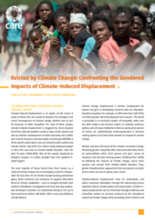Tackling the triple injustices: Gender, climate, social
Climate-induced displacement is an option of last resort. It preys on those who are unable to adapt to the ecological and social consequences of climate change, whether due to lack of resources or other inequities. For most of these people, climate-induced displacement is triggered by direct physical harm from extreme weather events or slow-onset impacts, but also by indirect consequences on food insecurity and conflict over natural resources and land rights. According to UNOCHA, 8 of the world’s worst food crises are linked to both conflict and climate shocksI. Out of the 33.4 million newly displaced people in 2019, 70% were due to climate-related disasters. Over the past 10 years (2008-2018), 90% of the people displaced by disasters (approx. 23 million people) have had weather-related triggers.
The vast majority of those forced from their homes as a result of climate change live in developing countries. Responsible for less than 4% of climate change-causing greenhouse gases, these countries lack resources to support alternative forms of climate adaptation - such as drought-resistant seed varieties, floodwater management and early warning systems. And developed countries are collectively failing to live up to their promise to deliver 100 billion USD in new and additional climate finance.
Climate change displacement is further compounded for women and girls in developing countries who are disproportionately impacted. For example, in 2018 more than half of the 41 million people internally displaced were women. The world is grounded in an exclusive system of inequality; white men are often leaders and decision makers in industry, business, politics, and all major institutions. Women, particularly women of colour, are systematically underrepresented in decision making spaces at all levels that prevent or respond to climate change.
Women also bear the brunt of the impacts of climate change. Prevailing gender inequality often intersects with other forms of vulnerabilities which limit women and girls’ access to resources and decision-making power, inhibiting their ability to withstand the impacts of climate change, access basic services and recover from climate-related disasters. Thus, gender-transformative approaches that put women and girls at the centre are not an option, but a must. Climate-induced displacement must be understood, and policy responses developed, through the intersecting lenses of gender justice, climate justice and social justice. Climate-induced displacement can be minimized through ambitious and immediate actions to increase resilience to the disruptions caused by climate change, while promoting more inclusive and sustainable communities and societies. It can be managed to ensure positive outcomes for communities that host those who have fled their homes, as well as those that have been left behind. When climate-induced disasters cannot be avoided, inclusive and gender-transformative approaches can ensure a more efficient and effective emergency response and recovery.

